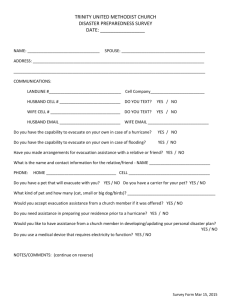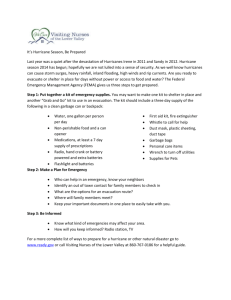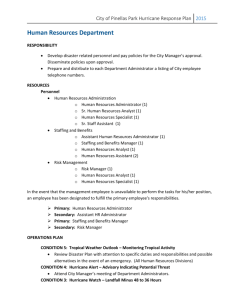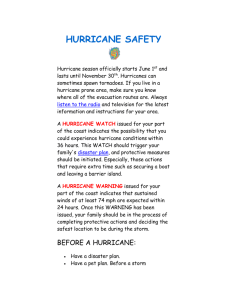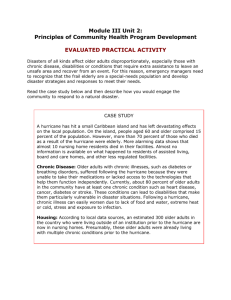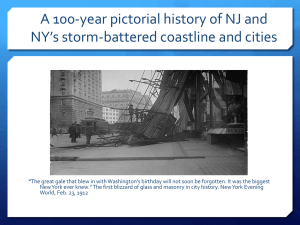MPH 584 – Community Health: Environmental Threat
advertisement
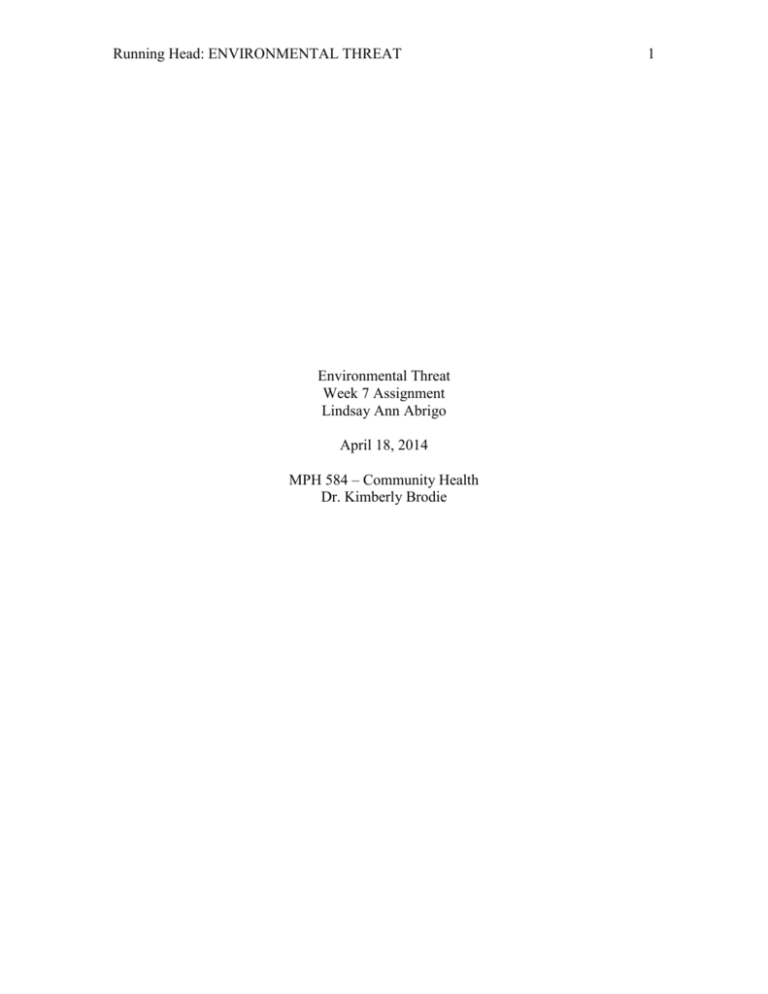
Running Head: ENVIRONMENTAL THREAT Environmental Threat Week 7 Assignment Lindsay Ann Abrigo April 18, 2014 MPH 584 – Community Health Dr. Kimberly Brodie 1 ENVIRONMENTAL THREAT 2 Hurricane hazards come in many forms, including storm surge, heavy rainfall, inland flooding, high winds, tornadoes, and rip currents (NOAA, 2014). The National Weather Service is responsible for protecting life and property through issuance of timely watches and warnings (NOAA, 2014), but it is essential that your family be ready before a storm approaches. During a hurricane, there is a triple threat of damage from high winds, elevated surf due to storm surge, and flooding associated with heavy rains (The American Red Cross, 2014). The greatest public health threat was from the loss of power, according to Manuel (2013). Hurricane Sandy knocked out electricity for more than 8.5 million people in 21 states, in 2012 (Manuel, 2013). This loss of power, coupled with the absence or flooding-related failure of backup generators, translated to the shutdown of heating systems, life support, and other technologies that were vital to people’s survival (Manuel, 2013). Additionally, flooding and loss of electricity pose serious health issues, in relation to food and water safety. The Food and Drug Administration emphasize the importance of keeping food and water safe when power outages and flooding should occur. Some basic tips for keeping food safe, in the event that the hurricane has caused a power outage, includes: keeping refrigerator and freezer doors closed as much as possible to preserve the cold temperature; when planning to consume refrigerated or frozen meat, poultry, fish, or eggs while they are still at safe temperatures, it is important that each food item is cooked thoroughly to assure that any foodborne bacteria present is destroyed (FDA, 2014). When flooding occurs, the following precautions are recommended by the FDA to keep both food and water safe: use bottled water that has not been exposed to flood waters; if no ENVIRONMENTAL THREAT 3 bottled water is available, boil water to make it safe as it will kill most types of diseasecausing organisms that may be present; refrain from consuming any food that may have come into contact with flood water; discard any food that is not in a waterproof container if there is any change that it has come into contact with flood water; inspect canned foods and discard any food in damaged cans; thoroughly wash cooking instruments and utensils (FDA, 2014). One misperception around the state is that a hurricane will only strike the island of Kauai and, therefore, residents of the other islands do not need to prepare. This is based on the impacts to Kauai from Hurricanes Dot (1959), ‘Iwa (1982), and Iniki (1992), states the American Red Cross (2014). However, this is not the case, it is essential that each of the Hawaiian Islands and its residents are adequately prepared for a hurricane or other emergency (The American Red Cross, 2014). When Hurricane Iniki hit in 1992, coordination among emergency personnel of the local level in Kauai and Oahu and the state and federal governments prior to, during, and after Hurricane Iniki significantly minimized the number of casualties. After the storm, public shelters were used to accommodate to some 12,000 people, respectively. On Oahu, 110 public shelters were opened, and an estimated 30,000 people sought public shelter for evacuation (U.S. Army Corps of Engineers, Federal Emergency Management Agency, 1993). Prizzia stated, “rather than sending tourists to public shelters, two major hotels kept their visitors in the buildings during the storm” (2007). Employees from the Department of Parks and Recreation, with some support from the American Red Cross, State Department of Education, the Salvation Army, and volunteers from the University of Hawaii, primarily staffed the shelters on Oahu, which were opened as “refuge only” shelters so they did not ENVIRONMENTAL THREAT 4 provide food, cots, blankets, medications, or other comfort items (U.S. Army Corps of Engineers, Federal Emergency Management Agency, 1993). During an emergency or threat of disaster, Civil Defense information will be broadcast over local radio and TV stations. When an evacuation is necessary, these broadcasts may include information about the location of public emergency shelters in affected areas (The American Red Cross, 2013). Additional information, including the location of shelters designated for people with special health needs and facilities for household pets may be broadcast, as well as when shelters will be opened for the public and will aid in directing evacuees to appropriate shelters (The American Red Cross, 2013). Each County Civil Defense will work in coordination with the Hawaii Red Cross to open hurricane evacuation shelters statewide and continue to monitor the needs for shelter once the storm has passed the islands The American Red Cross, 2013). Due to Hawaii’s isolation and vulnerability, Red Cross and Civil Defense recommend that people prepare their emergency kits for 7 days and bring their emergency supplies with them to shelters because airports and ports may be damaged by the storm and slow down the resupply process for local stores (2013). In addition to opening evacuation shelters, the City and County of Honolulu, Department of Emergency Management along with the Department of Civil Defense Division, provide printable information sheets to learn more about how to be prepared for a disaster such as a hurricane, guidelines on how to put together a basic disaster supplies kit, develop an emergency plan, etc. Emergency preparedness kits should contain the essentials families need to survive during a disaster. Having two is ideal; a multi-purpose kit that with provisions for ENVIRONMENTAL THREAT 5 more activities for the home and a transportable slimmed down kit with bare necessities for survival when on the go (Hawaii State Civil Defense, n.d.). When preparing a disaster preparedness kit, first plan for the essentials for survival. Think practical first, and think comfortable second. All essential needs should be able to fit in a 5-gallon bucket; absolute necessities include food, water, and warmth (Hawaii State Civil Defense, n.d.). Any preparations should be accompanied by an emergency plan, in addition to knowing where family members are and how to keep in contact in the event of a disaster. History teaches that a lack of hurricane awareness and preparation are common threads among all major hurricane disasters. By knowing and understanding vulnerability and what actions should be taken, individuals, families, and the community as a whole can reduce the effects of a hurricane disaster. Being prepared for disaster is important. When disaster strikes, there may not have ample time to respond and ensure the resources necessary to survive are available. Moreover, hundreds of other families in the area share the same concerns, and it will be difficult to get access to the necessities needed due to shortages and competition. ENVIRONMENTAL THREAT 6 References The American Red Cross, Hawaii State Chapter. (2013). Disaster preparedness: Hurricanes. Retrieved from website: http://www.redcross.org/hi/honolulu/ programs-services/disaster-preparedness/hurricanes Food and Drug Administration. U.S. Department of Health and Human Services, (2014). What consumers need to know about food and water safety during hurricanes, power outages, and floods. Retrieved from website: http://www.fda.gov/food/resourcesforyou/consumers/ucm076881.htm Hawaii State Civil Defense, (n.d.). Recommendations for disaster preparedness kit. Retrieved from website: http://www.scd.hawaii.gov/dp_kit.html Manuel, J. (2013). The long road to recovery: Environmental health impacts of hurricane sandy. Environmental Health Perspectives, 121(5), A152–A159. Retrieved from http://ehp.niehs.nih.gov/121-a152/ National Oceanic and Atmospheric Administration, National Weather Service, National Centers for Environmental Protection. (2014). National hurricane center. Retrieved from website: http://www.nhc.noaa.gov Prizzia, R. (2007). The role of coordination in disaster management. Disaster Management Handbook, Retrieved from http://www.huizenga.nova.edu/5463/ Readings/C005 Coordination in Disaster Management.Prizzia.pdf U.S. Army Corps of Engineers, Federal Emergency Management Agency. (1993). Hurricane Iniki assessment: Review of hurricane evacuation studies utilization and information dissemination. Retrieved from Post, Buckley, Schuh, & Jernigan, Inc. website: http://www.csc.noaa.gov/hes/docs/postStorm/ H_INIKI_ASSESSMENT_REVIEW_HES_UTILIZATION_INFO_DISSEMINA TION.pdf


